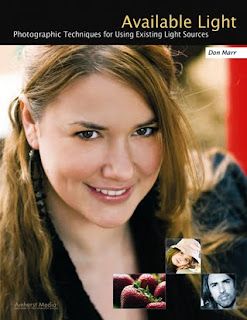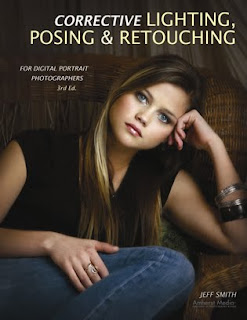 Today's post comes from the book Available Light: Photographic Techniques for Using Existing Light Sources by Don Marr. It is available from Amazon.com and other fine retailers.
Today's post comes from the book Available Light: Photographic Techniques for Using Existing Light Sources by Don Marr. It is available from Amazon.com and other fine retailers.Here we will challenge you to find the “buried treasures” of lighting. These are what I call Pockets of Light or Sun Spotlights. Normally we walk right by them, but I would like to invite you to slow down and find them. “Okay,” you say, “What the heck are they?” They are areas that seem to have their own special highlight on them, a spot where a little kiss of light seems to be telling a story. It’s a place that is lit with different light than anything around it, almost like a big stage light was put up in a tree to light the scene. This may sound like I want you take a trip to never-never land (Don’t go! The food is terrible.), but what I really want is for you to find these spots close by in your neighborhood. It could be the morning sun that comes in your window to light your spouse doing the Times crossword. It could be the lamppost on the corner that illuminates the pedestrians on the sidewalk at dusk. It could be the last bit of sunset light on the wall of your office.
One place to find a Pocket of Light is under some tree branches in an area of dappled light. Now, every bit of advice I’ve ever heard about making portraits has said to avoid this type of light. It leaves unappealing lines on peoples face and creates high-contrast edges. Shooting portraits in dappled light should be avoided at all costs. End of story, right? Well, all of that can be true—if you choose the wrong type of dappled light. If you choose the right kind, however, you can make beautiful portraits that are reminiscent of Hollywood portraits from the 1930s and 1940s.
When working with dappled light, you need to find areas with soft-edge shadows—and the best place to find soft-edge shadows is where there are trees. When shadows come from distant objects, such as tree leaves and branches that are perhaps twenty feet or more from the subject, the shadows created have a very soft edge. This is good. On the other hand, if the shadows come from leaves that are very close to the subject, then the shadow edge will be very hard and crisp. This is bad.
The key to working with dappled light is patience, on your part and your model’s. When you find some nice soft-edge shadows to work with, you will notice that the light acts like a spotlight; it will light only small areas. If the subject moves slightly, it can change the whole look of the shot. Where light may have been lighting their eyes a few seconds ago, it may now be lighting their ear. What happened? Chances are that your subject moved. Carefully coax them back to the original position (offers of money usually do the trick). This type of “spotlighting” can test the patience of your subject. Get them in a comfortable pose or position that they will be able to hold for a while, because you don’t want them to move out of the light. Reassure them by telling them that Cary Grant and Ingrid Bergman held their poses, too.
Morning and late afternoon are the best time to shoot with dappled light, mainly as it relates to the angle of the light hitting your subject.When the sun is lower in the sky, the light will come at your subject’s eyes more directly and produce a nice catchlight. If the sun is too high in the sky, your subject will have to turn their head skyward for the catchlights to be seen from the camera.
It’s possible to get different contrast effects in your shots with dappled light, depending on the where you are shooting. I have found that shooting in an urban environment works best for getting extra fill light into a portrait, because a lot of light bounces off pavement and buildings to fill in the shadow areas. If you want more drama, work with dappled light in the forest. The dark forest floor and surrounding trees do not bounce as much light as a city environment. Your natural sun spotlights will create a higher contrast between highlight and shadow in the forest, adding drama to your portraits.
Visual High Points
Here’s an important idea: an interesting portrait, or any photograph for that matter, has visual high points and other less important areas. Important parts of the subject are emphasized with light, while less important areas are kept shaded. Beginning photographers often make the mistake of lighting their subjects too evenly. That may work for shooting evidence and medical photos, but it makes for a boring portrait. Taking a cue from the classic Hollywood glamour portraits, where shadows and highlights created mystery, drama, and visual high points, you can look for where the sun creates its own Hollywood sets—right in your own neighborhood.
Do some research on the famous Hollywood glamour photographers. George Hurrell was a master at creating beautiful interplay between highlights and shadows. Also, the work of Laszlo Willinger, Ernest Bachrach, and C. S. Bull should inspire you to look for your own natural Hollywood lighting.
Here is a series to show you the possibilities that exist right in your neighborhood. In this scene (above), there is an area that is a Pocket of Light. Can you find it? It’s the area of sunlight just to the left of the doors. On sunny days, look for these little spotlights created by the sun. They make for excellent portrait opportunities, but they will require a bit of work from you and your subject.
Look for pockets of light that are about half the size of your subject. This will allow the light to create highlights in the areas that are getting direct sun but also allow the light to fall off into the darker, shaded areas. In this case (below), the subject was placed at the wall near the spotlight effect of the sun. The sun lit her left shoulder, but her face was just at the edge of the shadow.
When the sun creates spotlights like this, it also creates shadows of various shapes, forms, and angles. For example, shadows from objects closer to the subject will have crisp edges, while shadows from objects further away will have softer edges. Notice the two types of shadows in this shot. There is a crisp shadow next to the model’s left shoulder from the overhang of the doorway. The shadows from the flowers also cast crisp shadows. But the subtle shadows on the left side of the model’s face are from the top of a plant to camera right, which is about twelve feet above the model. These will come into play in the next shot.
Reviewing the above image a bit more, notice how your eye keeps looking to the back wall, because it’s the brightest area in the shot. It’s a nice wall—but this is a portrait of her, not the wall. Changing the point of view to take advantage of the shadows (below) helps to take some of the attention away from the bright wall. Also, we can really start to see the potential of the soft light and shadows from this direction. Moving in close to the subject has helped, as well.
Additionally, setting the aperture at wide open, to create a shallow depth of field, helped to throw the background out of focus and keep the emphasis on the subject’s face. It’s not necessary to have a lot of depth of field when doing a portrait. A shallow depth of field keeps the emphasis on the person you are photographing while blurring any distractions in the background. In fact, you need just enough depth of field to get the face in focus—and sometimes it’s even enough to just have the eyes in focus. Further still, sometimes it’s enough just to have the eye that is closest to the camera in focus. If the forward eye is in focus, then your portrait is “in focus.”
For the next shot (above), the model was directed to turn her head up to the light. This produced some nice catchlights in her eyes. (Because of the soft-edge shadows, the sun was not too bright for her to keep her eyes relaxed. Squinting eyes don’t make for good portraits!) Notice how the light is subtly brighter on her forehead and eyes than on her chin. This is the subtle shadow edge of the plant twelve feet above her. It can be difficult to work with these sun “spotlights” since they don’t stay static. They move as the sun moves. Your model will have to be patient, too, as you instruct her or him to angle their face to the best light-catching position.
Lastly, the image was converted to black & white (above) as homage to the great George Hurrell. Keep your eyes open to find these sun spotlights or Pockets of Light. Whatever you want to call them, they’re out there.
In our next series of dappled light shots (below), morning sunlight spilled through tree branches and leaves. The morning sun, as it passed through the leaves, was not difficult for the model to look toward. (Squintfree light!) A pleasing soft spotlight was created on her face from the softedge shadows. The light fell off toward her hair and right shoulder, keeping the emphasis on her face. Since the tree branches and leaves were about fifty feet away, the shadows formed were very soft. If you aren’t sure where to find these soft-edge shadows in the area you are shooting in, just look at the ground or a wall. Chances are the sunlight will be making both soft and hard shadows from different branches and leaves at varying heights and it will show on these surfaces.















